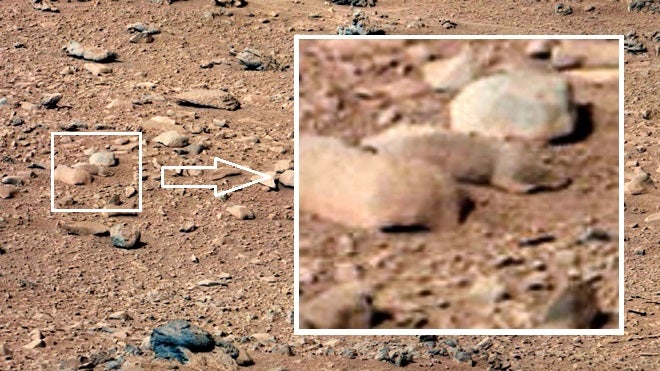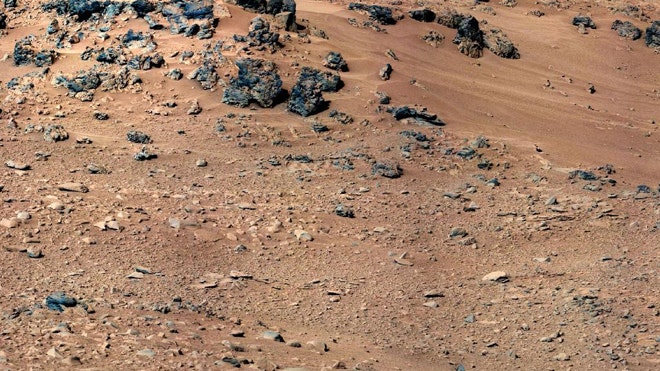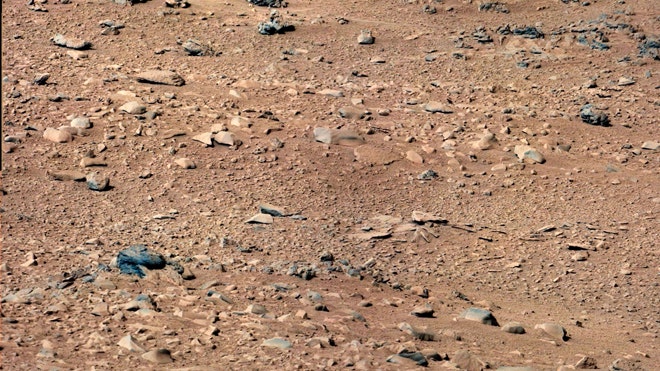'Mars rat' spied by NASA's Curiosity rover
Published May 29, 2013
FoxNews.com
 The patch of windblown sand and dust downhill from a cluster of dark rocks labeled the "Rocknest" site, where eagle-eyed believers think they've uncovered a "space rat." (NASA/JPL-Caltech/MSSS)
The patch of windblown sand and dust downhill from a cluster of dark rocks labeled the "Rocknest" site, where eagle-eyed believers think they've uncovered a "space rat." (NASA/JPL-Caltech/MSSS)  A zoomed-in view of the "Rocksnest" spot; the patch of rocks in question is seen at the lower-left side. (NASA/JPL-Caltech/MSSS)
A zoomed-in view of the "Rocksnest" spot; the patch of rocks in question is seen at the lower-left side. (NASA/JPL-Caltech/MSSS)  An even closer, zoomed-in view of the "Rocksnest" spot; the "rodent" is seen at the top left. (NASA/JPL-Caltech/MSSS)
An even closer, zoomed-in view of the "Rocksnest" spot; the "rodent" is seen at the top left. (NASA/JPL-Caltech/MSSS)
Is that a rat on Mars?
A photo from the mast camera on NASA’s Curiosity rover reveals the dusty orange, rock-strewn surface of the Red Planet -- and what starry-eyed enthusiasts claim is a dusty orange rodent hiding among the stones.
The photo, taken Sept. 28, 2012, depicts the “Rocknest” site , where NASA’s rover took a scoopful of sand, tasted it, and determined it was full of weathered basaltic materials -- not unlike Hawaii, the space agency’s scientists said last year.
, where NASA’s rover took a scoopful of sand, tasted it, and determined it was full of weathered basaltic materials -- not unlike Hawaii, the space agency’s scientists said last year.
'Note its lighter color upper and lower eyelids, its nose and cheek areas, its ear, its front leg and stomach.'
- ScottCWaring on the blog UFO Sightings Daily
No word on how the rodent tasted, however.
The “creature” was identified on the UFO Sightings Daily website , where its finder, ScottCWaring, held tight to his opinion: That’s one darn cute rodent on Mars.
, where its finder, ScottCWaring, held tight to his opinion: That’s one darn cute rodent on Mars.
“Note its lighter color upper and lower eyelids, its nose and cheek areas, its ear, its front leg and stomach. Looks similar to a squirrel camouflaged in the stones and sand by its colors," he wrote. "Hey, who doesn't love squirrels, right?”
Others pointed out that the similarity in coloring and position mean it was most likely just a rock, fingering the psychology phenomenon known as pareidolia, a propensity to pick out faces from everyday objects and structures.
To take advantage of this psychological phenomenon closer to home, designers at Berlin's Onformative studio developed an algorithm that scans the surface of the earth with Google Maps, picking out geographical structures that are likely to be construed as having face-like features, science blog iO9 recently pointed out .
.
Their algorithm found faces in fields, mustaches in mountains, hills with actual eyes.
Perhaps the algorithm should be turned loose on Mars?
Read more: http://www.foxnews.com/science/2013/05/29/mars-rat-spied-by-nasa-curiosity-rover/#ixzz2UnkMBSwm

Nenhum comentário:
Postar um comentário